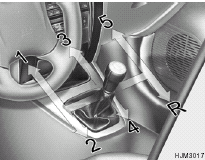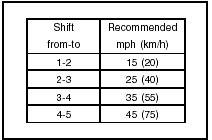 Hyundai Tucson: Operating the manual transaxle
Hyundai Tucson: Operating the manual transaxle

Your Hyundai's manual transaxle has a conventional shift pattern. This shift pattern is imprinted on the shift knob. The transaxle is fully synchronized in all forward gears so shifting to either a higher or a lower gear is easily accomplished.
NOTE: o To shift into reverse, rest the lever in neutral for at least 3 seconds after your car is completely stopped. Then move the lever into the reverse position. o During cold weather, shifting may be difficult until the transaxle lubricant has warmed up. This is normal and not harmful to the transaxle. o If you've come to a complete stop and it's hard to shift into 1st or R(Reverse), put the shift lever in N(Neutral) position and release the clutch. Press the clutch pedal down, and then shift into 1st or R(Reverse) gear position. o Do not use the shift lever as a handrest during driving, as this can result in premature wear of the transaxle shift forks.
CAUTION: When downshifting from fifth gear to fourth gear, caution should be taken not to inadvertently press the gear lever sideways in such a manner that second gear is engaged. Such a drastic downshift may cause the engine speed to increase to the point that the tachometer will enter the red-zone. Such over-revving of the engine may cause engine damage.
Using the Clutch
The clutch should be pressed all the way to the floor before shifting, then released slowly. The clutch pedal should always be fully returned to the original position. Do not rest your foot on the clutch pedal while driving. This can cause unnecessary wear. Do not partially engage the clutch to hold the car on an incline. This causes unnecessary wear. Use the foot brake or parking brake to hold the car on an incline. Do not operate the clutch pedal rapidly and repeatedly.
 Recommended Shift Points
Recommended Shift Points
The shift points as shown on the chart are recommended for optimum fuel economy and performance.
Good Driving Practices
o Never take the car out of gear and coast down a hill. This is extremely hazardous. Always leave the car in gear. o Don't "ride" the brakes. This can cause them to overheat and malfunction. Instead, when you are driving down a long hill, slow down and shift to a lower gear. When you do this, engine braking will help slow the car. o Slow down before shifting to a lower gear. This will help avoid over-revving the engine, which can cause damage. o Slow down when you encounter cross winds. This gives you much better control of your car. o Be sure the car is completely stopped before you attempt to shift into reverse. The transaxle can be damaged if you do not. To shift into reverse, depress the clutch, move the shift lever to neutral, wait three seconds, then shift to the reverse position. o Exercise extreme caution when driving on a slippery surface. Be especially careful when braking, accelerating or shifting gears. On a slippery surface, an abrupt change in vehicle speed can cause the drive wheels to lose traction and the vehicle to go out of control. o Optimum vehicle performance and economy is obtained by smoothly depressing and releasing the accelerator pedal.
WARNING: o Always buckle-up! In a collision, an unbelted occupant is significantly more likely to be seriously injured or killed than a properly belted occupant. o Avoid high speeds when cornering or turning. o Do not make quick steering wheel movements, such as sharp lane changes or fast, sharp turns. o The risk of rollover is greatly increased if you lose control of your vehicle at highway speeds. o Loss of control often occurs if two or more wheels drop off the roadway and the driver oversteers to reenter the roadway. o In the event your vehicle leaves the roadway, do not steer sharply. Instead, slow down before pulling back into the travel lanes. o Never exceed posted speed limits.
 Starting
Starting
Starting
WARNING:
Never run the engine in a closed or poorly
ventilated area any longer than is needed to
move your car in or out of the area. The
carbon monoxide gas emitted is odorless
...
 Operating the automatic transaxle
Operating the automatic transaxle
The highly efficient Hyundai automatic transaxle
has four forward speeds and one reverse
speed. The individual speeds are selected automatically,
depending on the position of the
speed selec ...
See also:
Summer and winter tires
The arrows shows the direction of rotation of the tire
• When switching between summer and
winter tires, mark the tires to indicate
where they were mounted on the car, e.g.,
LF = left front ...
Programming trouble-diagnosis
If HomeLink® does not quickly learn the handheld
transmitter information:
- replace the hand-held transmitter batteries
with new batteries.
- position the hand-held transmitter with its
batt ...
Foreword
Welcome to the growing family of new NISSAN
owners. This vehicle is delivered to you with
confidence. It was produced using the latest
techniques and strict quality control.
This manual was pre ...
